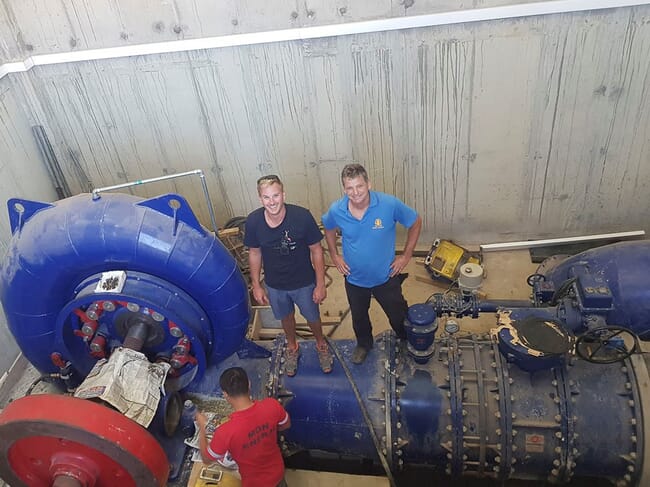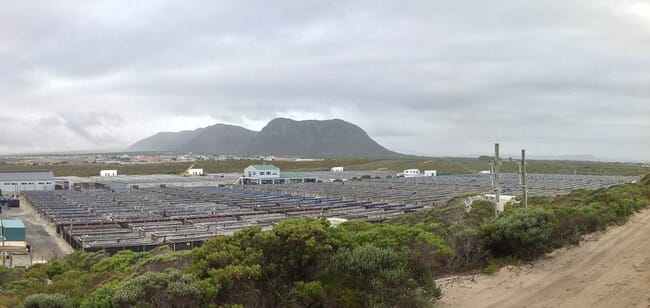With a current output of 1,200 tonnes per year, South Africa is the largest producer of farmed abalone outside Asia. The local abalone species, called perlemoen, are esteemed by Chinese consumers and enjoy premium prices, typically around US $40 per kilogram.
This justifies the expense of growing perlemoen in tanks on land, a process made possible by continuous pumping of seawater from the ocean. Unsurprisingly, given the need for this throughput of water, electricity accounts for about a fifth of production costs.

© Graeme Hatley
The other main outlays are labour and feed and - together with electricity – these items account for around 65 percent of production costs. However, abalone growers are coming under pressure to cut back costs and to improve sustainability and several farmers see renewable energy making a key contribution to their electricity needs.
"We are not just thinking about tomorrow. We are looking ten, 20 years ahead. In reality, electricity is still relatively inexpensive in South Africa and prices will only go up," says Adriaan Hanekom, group engineering manager for Aqunion.
Aqunion owns Whale Rock and Romansbaai abalone farms on the Cape’s south coast. Whale Rock produces 80 tonnes of abalone per year and Romansbaai about 250. Romansbaai uses almost two megawatts per hour at present and this is set to increase as the farm expands to 360 tonnes over the next two years. After investigating all the options, Aqunion implemented a hybrid system at Romansbaai, which is able to coordinate different energy sources. These include solar panels, diesel generators and a hydro turbine.
Turning waste water into watts
"Our farm is actually in a really bad place. Our hydraulic head is massive," Hanekom says, "our elevation is 43 metres."
Romansbaai is making the best of an unfavourable situation. The newly installed hydro turbine in their effluent line will allow them to recoup about a third of their total pumping costs. Gamco Services, a local marine engineering company, helped design the turbine, which was manufactured in China.
"Ideally, you don't want a turbine, you want to be at sea level," Hanekom sighs, "but we're not."
Besides the turbine, Romansbaai has been running a 55-kilowatt pilot solar project. Impressed by the performance of the photovoltaic panels, they are scaling up to 500-kilowatt peak from next year. Emergent Energy, their service provider, has also installed a 282 kWp system at neighbouring Atlantic Abalone, a 120-tonne farm.
"That was a great project, because it gave them three benefits," says Natasha Watkins-Baker, business development manager at Emergent Energy, referring to their work at Atlantic Abalone.
Atlantic Abalone installed the solar panels above their tanks. Watkins-Baker points out that, besides generating electricity, the panels provide shade. Shaded abalone fetch higher prices due to better shell colour. Exclusion of marauding gulls is yet another advantage.
Making power while the sun shines
Agriculture was the first industry in South Africa to embrace renewables. Although cost saving is the main driver, Watkins-Baker highlights positive pressure from international markets as an added incentive.
"They can't avoid the carbon footprint of shipping their wine or their fruit or whatever it is overseas. So a way to reduce that is by saying that 30 or 40 percent of their energy consumption is carbon neutral."
Watkins-Baker has seen the regulatory environment become more supportive in recent years. Most Western Cape municipalities credit users when they feed excess solar energy back into the grid. "So you can overproduce during the daylight hours and then use all that energy you produce during the day in the night," she explains. In this way the municipality acts as an alternative to battery storage.

© Aqunion
Emergent Energy works closely with clients to design systems that fit their needs. "We model the energy consumption, we use their exact location, the angles of the panels, what the shading is," explains Watkins-Baker. "We use that with the electricity tariffs in our financial model. Once we have a system installed, we take what we predicted and we see what is actually produced on site."
So far, the actual performance has been between 98 and 105 percent of the prediction. Emergent Energy is so confident in their model, they offer a guarantee.
It's an ill wind that blows no turbine
Emergent Energy is less convinced about wind. "We can't model it accurately," says Watkins-Baker. "I can't go to a client and tell them please invest a million rands and not be able to say what savings they will get." Whereas, Watkins-Baker adds, "You know the sun is rising every day."
"Well, I can tell you, I am more sure of the wind blowing at Buffelsjachts than I am of the sun rising," jokes Bertus van Oordt, executive director of HIK Abalone. Their main site is in Hermanus and produces 150 tonnes per year. HIK Abalone is developing South Cape Abalone, a 120-tonne farm, at Buffelsjachts, so Van Oordt knows what he is talking about.
Based on a detailed feasibility study, HIK Abalone decided against pursuing renewable energy.
Van Oordt spells it out: "There are only two renewables. Sun and wind. That's all there is. We looked at installing three wind turbines. That would have saved us 1.8 million rands, but our total input cost would have been 15 million rands. We would have borrowed the capital and the interest would have gobbled up the 1.8 million."
The figures look even worse for solar.
The main reason is that South Cape Abalone can't store surplus energy. Buffelsjachts is a remote location, not serviced by a municipal grid. The farms there deal directly with Eskom, the South African public utility for electricity. Eskom will not allow South Cape Abalone to put electricity back into the grid.
"So now, what happens is, we generate power, and if it is too much, it disappears. Because battery storage is simply too expensive," says Van Oordt.
South Cape Abalone uses about one megawatt per hour, of which three-quarters goes to pumps and blowers. These run 24 hours a day, every day, but renewable energy sources don't.
"I am completely in favour of renewable energy. It's the cleanest," affirms Van Oordt. "But the sum only works if you can store your surplus in the Eskom grid."
Winds of change
Around the corner from South Cape Abalone lies Buffelsjags Abalone, set to expand to 300 tonnes by 2020. They are erecting three wind turbines.

Buffelsjags Abalone will be putting their surplus electricity back into the grid.
"It's taken us a very long time, but we have now finally concluded an agreement with Eskom," says Nick Loubser, operations director for Viking Aquaculture, who own Buffelsjags Abalone.
Viking Aquaculture have sourced used wind turbines from Vestas, a Danish wind energy company. Vestas refurbishes the turbines and offers a guarantee.
"The wind profile at Buffelsjachts is very good," says Loubser. "We reckon we'll get between 70 and 75 percent usage out of the turbines."
Loubser gives two reasons why they are pursuing renewable energy at Buffelsjags Abalone. "One is that we are at the end of a 70 km line and we get a lot of dips in electricity."
"The second is that we think electricity costs might still continue to increase beyond inflation over the coming years. We are aware that abalone farming is expanding rapidly and we are concerned about pressure on price and margins."
"We thought that putting in renewable energy will help reduce our costs going forwards. The farms that can produce the cheapest abalone will be the guys that continue to grow."
South African abalone production is set to double over the next five years, to around 2,500 tonnes. It follows that perlemoen farmers who see which way the wind is blowing will be building turbines. Perhaps erecting solar panels too.



